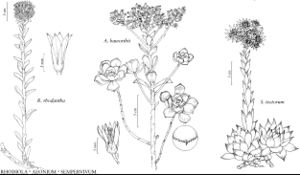Sempervivum tectorum
Sp. Pl. 1: 464. 1753 ,.
Leaves: rosettes usually open, 4–10 cm diam., producing offsets attached to parental plants by stout stolons; blade 1–1.5 cm wide, apex stoutly mucronate, surfaces usually glabrous, sometimes sparingly hairy (some cultivars are hairy). Inflorescences erect, flat-topped to thyrsiform cymes, 10–40(–100+)-flowered, bracteate, (10–)20–30(–50) cm, usually 5–15 cm diam.; bracts 1 per flower, clasping at base, ovate-lanceolate, base narrow. Flowers: petals strongly reflexed at anthesis, 9–12 mm, margins entire, abaxially pubescent; stamens red to purple. 2n = (36, 40), 72.
Phenology: Flowering usually mid summer–fall.
Habitat: Rocky microsites such as rocky outcrops, stone walls, rock piles, adjacent to rocks, along cliff bases
Elevation: 0-1000 m
Distribution

Introduced; Conn., Maine, Mass., N.J., N.Y., Utah, Va., Europe.
Discussion
Sempervivum tectorum has naturalized populations in the flora area but is rarely, if ever, considered an aggressive competitor with or threat to native species. Populations occur in areas that provide a measure of physical protection because they are intolerant of treading effects.
Sempervivum tectorum is highly variable. H. ’t Hart et al. (2003) recognized two varieties [var. arvernense (Lecoq & Lamotte) Zonneveld and var. tectorum] and presented an extensive synonomy for var. tectorum. Hundreds of cultivars have been propagated, sold, and traded for nearly 200 years. The variety of forms that could be found naturalized is large; any given naturalized population may differ in certain characteristics from the description above.
Selected References
None.
